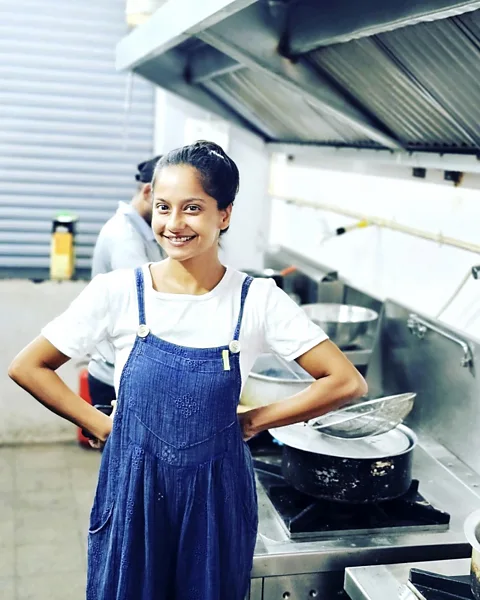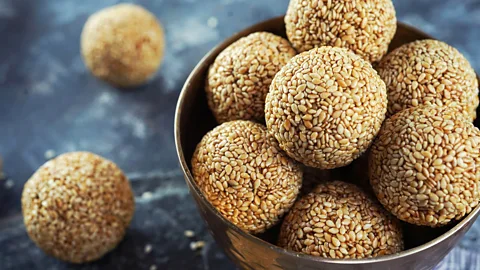Tilgul: A Indian sweet that encourages kind words
 Teja Lele
Teja LeleDuring the festival of Makar Sankranti, this warming sweet made with sesame and jaggery goads us to speak kind words and ultimately walk the right path in the year to come.
My cousin handed me a fistful of a tilgul, a simple gul (jaggery) and sesame sweet made with ghee (clarified butter), whispering words that everyone should carry with them at all times of the year: "tilgul ghya, goad-goad bola" ("take this sweet, speak good and kind words"). The words, a mantra for joyful and kind-hearted living, are typically spoken as people exchange the treat in the western state of Maharashtra to mark Makar Sankranti, an Indian holiday on 14-15 January that honours the year's end and a new beginning.
As children, my cousins and I grabbed chunks of the tilgul – available as ladoo (round sweets), papdi (brittle), barfi (fudge), revdi (coin-sized treats), gajak (bars) and other forms – as we beelined for the door to the yard to resume playtime. The significance of the words was lost on us at that time; today, as mums ourselves, we realise the importance and implication of exhorting kindness and goodness in a world that can be unbearably hard and hostile.
The only Hindu festival based on the solar calendar instead of the lunar, Makar Sankranti celebrates the Sun's journey from the southern to the northern hemisphere and the transmigration of the Sun from one zodiac to another – from dhanu (Sagittarius) to makar (Capricorn).
Apart from the astrological significance, Makar Sankranti is also a harvest festival, a time to express thanks to Mother Earth for a bountiful harvest. The festival, which officially marks the end of winter and beginning of longer days, is celebrated across India in different ways and under different names. However, most festivities are incomplete without white sesame seeds, known as til in India, whether in various sweet forms or by themselves.
Rice instead of sesame
In the south, the people of Tamil Nadu celebrate what's called Pongal over three days, marking the festival with a sweet dish made of rice and milk of the same name, which translates into "overflow". Rice and milk are boiled and allowed to overflow out of a pot; the bubbling over signifies abundance, prosperity and good luck.
In northern India, particularly in the state of Punjab, farmers observe the new year during the festival (called Lohri), expressing gratitude and praying for abundance. They sing and dance around bonfires, enjoying revdi, a crunchy, coin-shaped treat made of sesame seeds and jaggery. In Bihar and Jharkhand in eastern India, the two-day celebration typically involves holy river baths in the morning, followed by bonfires where sesame seeds are offered. Called Suggi in the south-western state of Karnataka, the harvest festival involves a special ritual – people exchange white sesame seeds mixed with fried groundnuts, jaggery and dry coconut. In Gujarat, the sky is dotted with kites on what's called Uttarayan as people scarf down tilgul chikki (a brittle made from sesame seeds and jaggery).
Indian folklore is rich with stories that link the humble sesame seeds with the gods. One story suggests that beads of sweat fell as "blessed" sesame seeds from the brow of Vishnu, the creator, during the "churning of the ocean of milk". Worshippers of Surya, the Sun god, believe that he is the source of all energy and life, and that sesame seeds contain solar energy. Another myth links the seeds to immortality; they are said to be blessed by Yama, the god of death.
Exchanging sweets made with sesame seeds is an intrinsic part of the celebrations across India. But only in Maharashtra is the essence of these shared sweets distilled down into kindness and forgiveness. Great-grandmothers here, including mine, have for decades said that Makar Sankranti is a festival that gives us a chance to share sweets with others, forget differences and live a more joyous life.
Chef Chinu Vaze, who lives in Goa and is the co-founder of upscale gourmet catering company Gaia Gourmet, says being expressly told to "eat sweets and speak sweet words" thrilled her as a child. "I have many memories. I recall teeth-breaking tilgul ladoos (round sweets made from sesame seeds and jaggery) and the crunchy, delicious ones that separated amateur ladoo makers from the pros. I also always loved the idea of asking people to speak sweetly even when I was a child," Vaze says.
 Chinu Vaze
Chinu VazeThe cookbook author and TV host says our ancestors knew that Makar Sankranti was time to celebrate the harvest and the coming of spring. However, since winter was still in the air, the need for warming, immunity-boosting foods was strong as well.
In honour of women
Makar Sankranti also brings with it a celebration for married women, called savashins, in Maharashtra and neighbouring Goa. The women organise and attend haldi-kumkum ceremonies, inviting friends and relatives to gather and pray for matrimonial bliss. The rituals involve applying haldi (turmeric) and kumkum (vermilion powder), considered extremely auspicious, on the foreheads and exchanging tilgul. The hostess also offers all savashins daan (charity) in the form of a vaan (gift), which typically includes fruit, a coconut and a small gift.
"Enter til and gul. Both these winter foods are warming, fire up your agni [inner fire], help digestion and boost immunity," she says, adding that consuming these two foods together helps tremendously in the prevailing cold-flu season.
Nutritionist Amita Gadre, who is based in Pune and runs her own practice, says people across India traditionally use produce that is in season for festivals. "Sesame seeds are harvested during this time and the new seeds are used in many preparations such as ladoo, revdi, gajak, et cetera," she says.
She adds that combining sesame seeds with jaggery works well during this season as the seeds are a great source of calcium and offer healthy fats. "They ensure slow release of energy, and when combined with jaggery the sweet treat – in moderation – ensures sustained release of energy," she says.
Vaze adds that adding ghee to tilgul ensures the "perfect balance of Omega 3, 6 and 9" during this festival and in the winter months.
The simple winter sweet synonymous with the festival may be health-giving and combine just a few pantry staples, but I now know that the sweet tradition of exchanging tilgul goads us, in a major way, to speak kind words, do good deeds and ultimately walk the right path in the year to come.
 vm2002/Alamy
vm2002/AlamyChef Chinu Vaze shares a variant of the traditional tilgul to make festive eating healthier.
Ingredients
For the sweet:
½ cup peanuts, roasted, peeled and ground not too fine
½ cup sesame seed, roasted; ¼ cup ground and ¼ cup whole
¼ cup peanut butter
2 tbsps cacao powder
¼ cup grated jaggery/gul
1 tbsp milk
½ tbsp ghee
1 pinch salt
For dipping chocolate:
¼ cup dark chocolate
2 tbsp coconut oil
whole sesame seeds
Method
Step 1
Roast and grind peanuts and sesame, setting aside half of the sesame seeds.
Step 2
Add the ghee to a pan along with the jaggery until it melts and starts bubbling. Add the milk. Mix in all the other ingredients and blend well.
Step 3
Start shaping the mix into round ladoos while it is still warm. Keep them in the fridge for 10-15 minutes to harden and then reshape into small balls.
Step 4
Melt the chocolate and coconut oil on a double boiler. Dip tilgul ladoos into it and then roll in sesame seeds.
BBC.com's World's Table "smashes the kitchen ceiling" by changing the way the world thinks about food, through the past, present and future.
---
Join more than three million BBC Travel fans by liking us on Facebook, or follow us on Twitter and Instagram.
If you liked this story, sign up for The Essential List newsletter – a handpicked selection of features, videos and can't-miss news delivered to your inbox every Friday.
